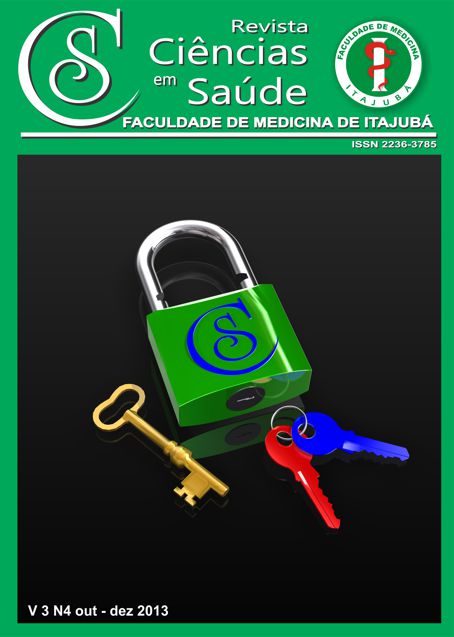Relação entre Ácido Úrico Sérico e Capacidade Antioxidante em uma População de Hipertensos Atendidos em Unidade Básica de Saúde do Sul de Minas Gerais/ Relation between Serum Uric Acid and Antioxidant Capacity in a Population of Hypertensive Patients in a
Main Article Content
Abstract
Objetivo: Investigar a relação entre os níveis séricos de ácido úrico e capacidade antioxidante com a pressão arterial em indivíduos hipertensos. Métodos: Foram coletados sangue e amostras de urina isolada de 76 sujeitos (21-65 anos) provenientes de unidade básica de saúde. Antes da coleta a pressão arterial foi aferida e os sujeitos foram divididos em três grupos: normotensos (N); hipertensos controlados (HC) e hipertensos não-controlados (HNC). Foram determinadas as concentrações séricas de ácido úrico, ureia, creatinina e capacidade antioxidante. Proteínas totais e creatinina foram determinadas em urina isolada. Resultados: Os valores médios de ácido úrico foram significativamente elevados no grupo HC (mulheres = 5,64±1,2mg/dL; homens = 6,1±2,6mg/dL) comparados aos normotensos (mulheres = 4,1±1,1mg/dL; homens = 5,1±1,8mg/dL) e HNC (mulheres = 4,82±1,1mg/dL; homens = 5,8±1,8mg/dL), p<0,001. Os valores de capacidade antioxidante expressos em μmol equivalentes Trolox/L foram significativamente maiores nos indivíduos usuários de inibidores da enzima conversora de angiotensina - IECA (690,9 ± 205,9) em comparação aos normotensos (568,0 ± 163,0) e usuários de outras classes de anti-hipertensivos (645,1 ± 145,0), p<0,01. Conclusão: Embora neste estudo o ácido úrico esteja elevado nos hipertensos, sua ação antioxidante pode contribuir diretamente para a diminuição do estresse oxidativo.
Palavras Chave: hipertensão, hiperuricemia, capacidade antioxidante
Objective: To investigate the relation between serum uric acid concentration and antioxidant status with blood pressure levels (BP) in hypertensive individuals. Methods: Blood and urine samples from 76 ambulatory patients (21-65 years-old) were analyzed. Based on the history and blood pressure levels, patients were divided into three groups: normal blood pressure (n=36), controlled hypertension (n=18) and not controlled hypertension (n=22). We analyzed urea, creatinine and serum antioxidant capacity from blood samples and proteins and creatinine from urine samples. Results: Controlled hypertension group had significantly higher blood uric acid (male=6,1±2,6mg/dl; female=5,64±1,2mg/dl) than normal (male=5,1±1,8mg/dl; female=4,1±1,1mg/dl) and not controlled blood pressure group (male=5,8±1,8mg/dl; female=4,8±1,1mg/dl; p<0,001). There was no correlation between uric acid and blood pressure. The values of antioxidant activity expressed in μmol equivalent Trolox/L were significantly higher in individuals treated with angiotensin converting enzyme (ACE) inhibitors (690,9 ± 205,9) than normotensive (568,0 ± 163,0) and users of other antihypertensive drugs (645,1 ± 145,0), p<0,01. Conclusion: Although in this study the uric acid is high in the hypertensive patients, its antioxidant activity may contribute directly to the reduction of oxidative stress.
Keywords: hypertension, hyperuricemia, antioxidant status.
Article Details
Authors maintain copyright and grant the HSJ the right to first publication. From 2024, the publications wiil be licensed under Attribution 4.0 International 
 , allowing their sharing, recognizing the authorship and initial publication in this journal.
, allowing their sharing, recognizing the authorship and initial publication in this journal.
Authors are authorized to assume additional contracts separately for the non-exclusive distribution of the version of the work published in this journal (e.g., publishing in an institutional repository or as a book chapter), with acknowledgment of authorship and initial publication in this journal.
Authors are encouraged to publish and distribute their work online (e.g., in institutional repositories or on their personal page) at any point after the editorial process.
Also, the AUTHOR is informed and consents that the HSJ can incorporate his article into existing or future scientific databases and indexers, under the conditions defined by the latter at all times, which will involve, at least, the possibility that the holders of these databases can perform the following actions on the article.

